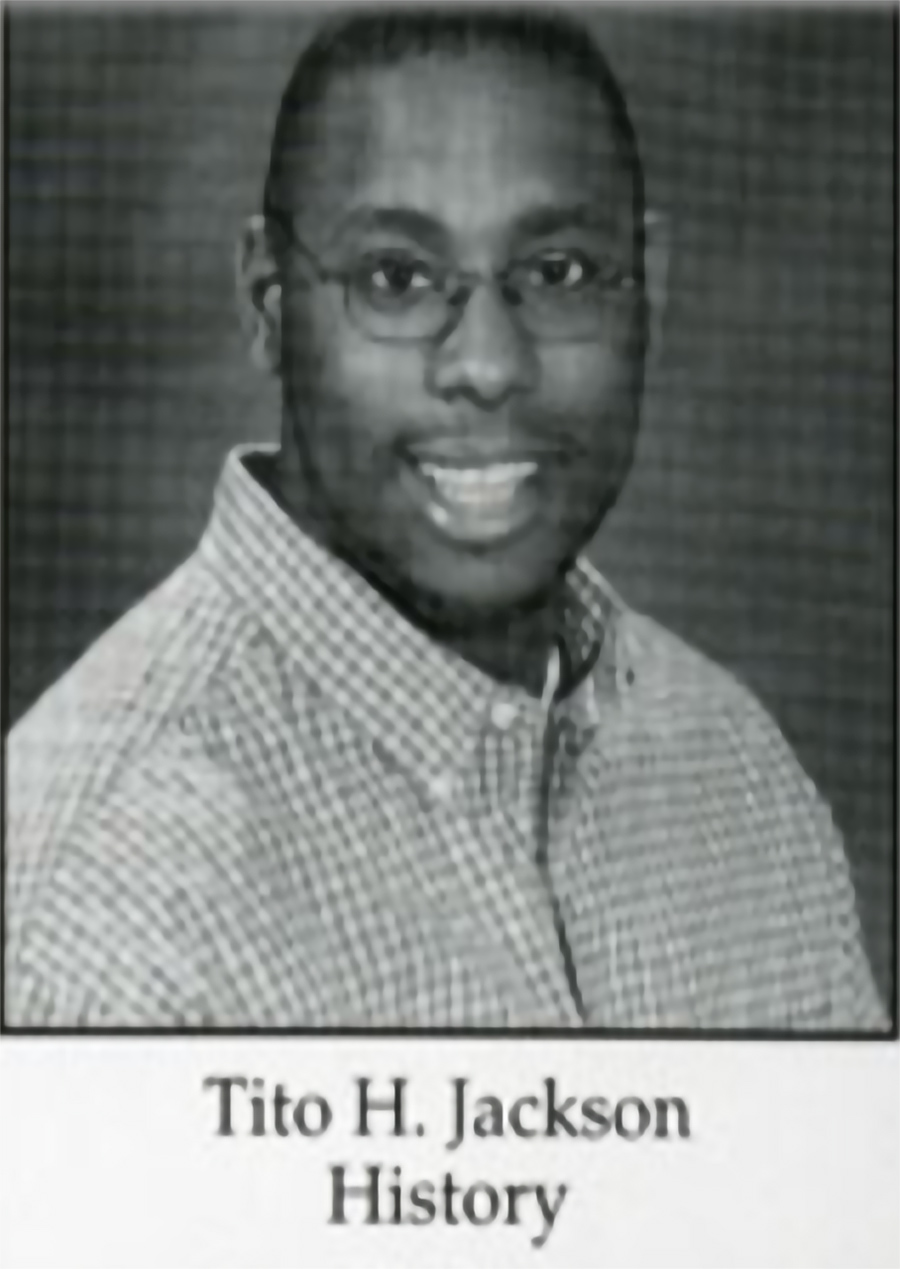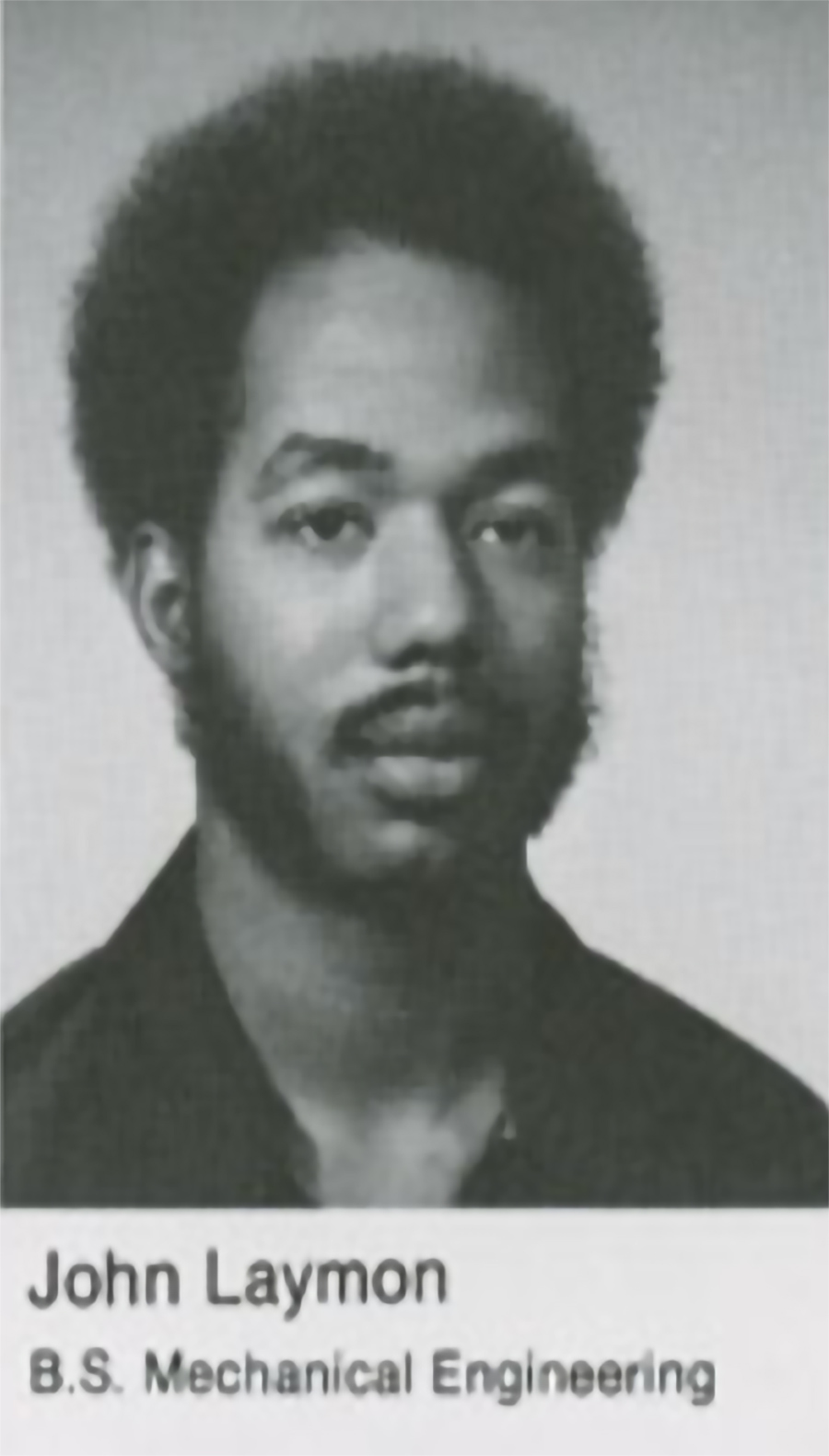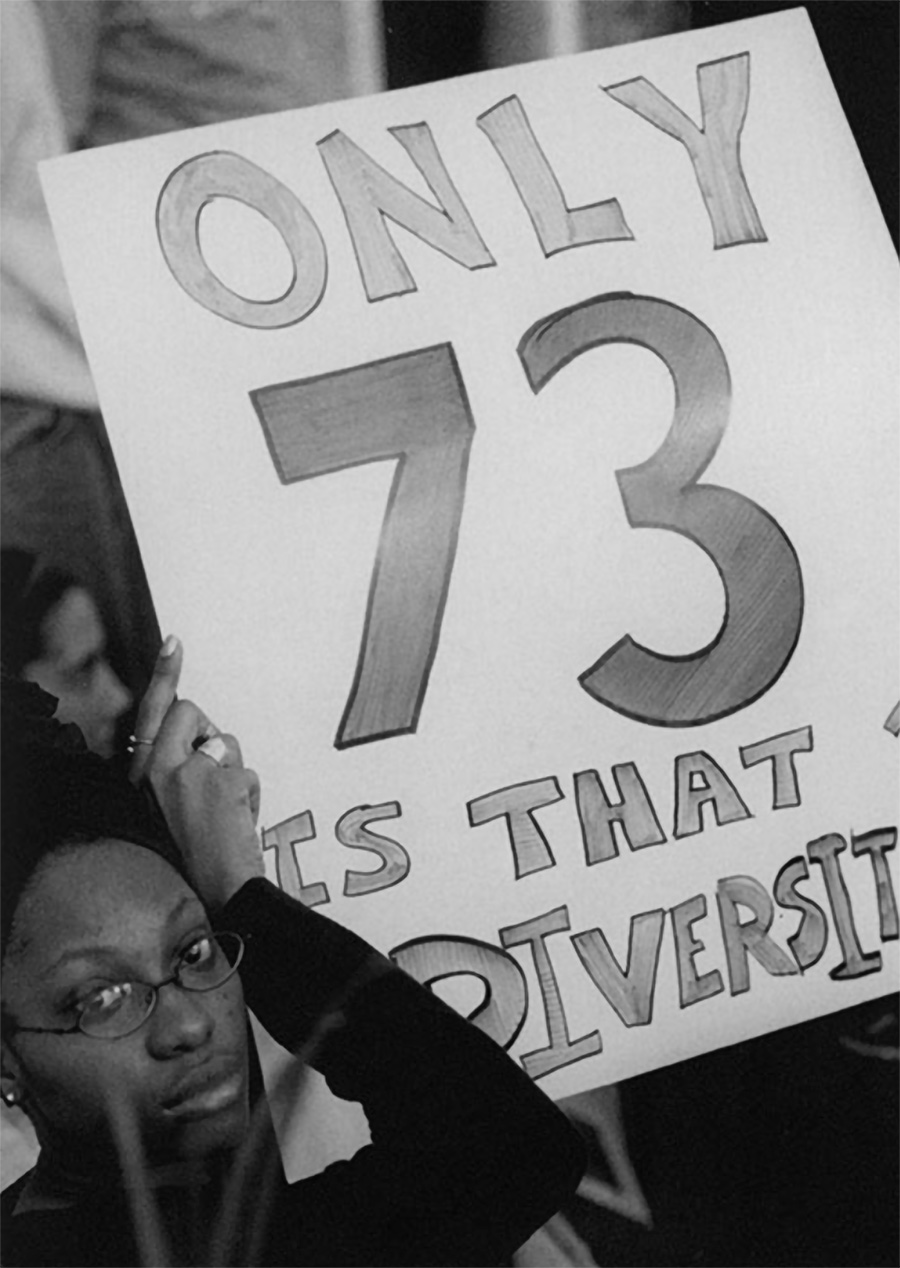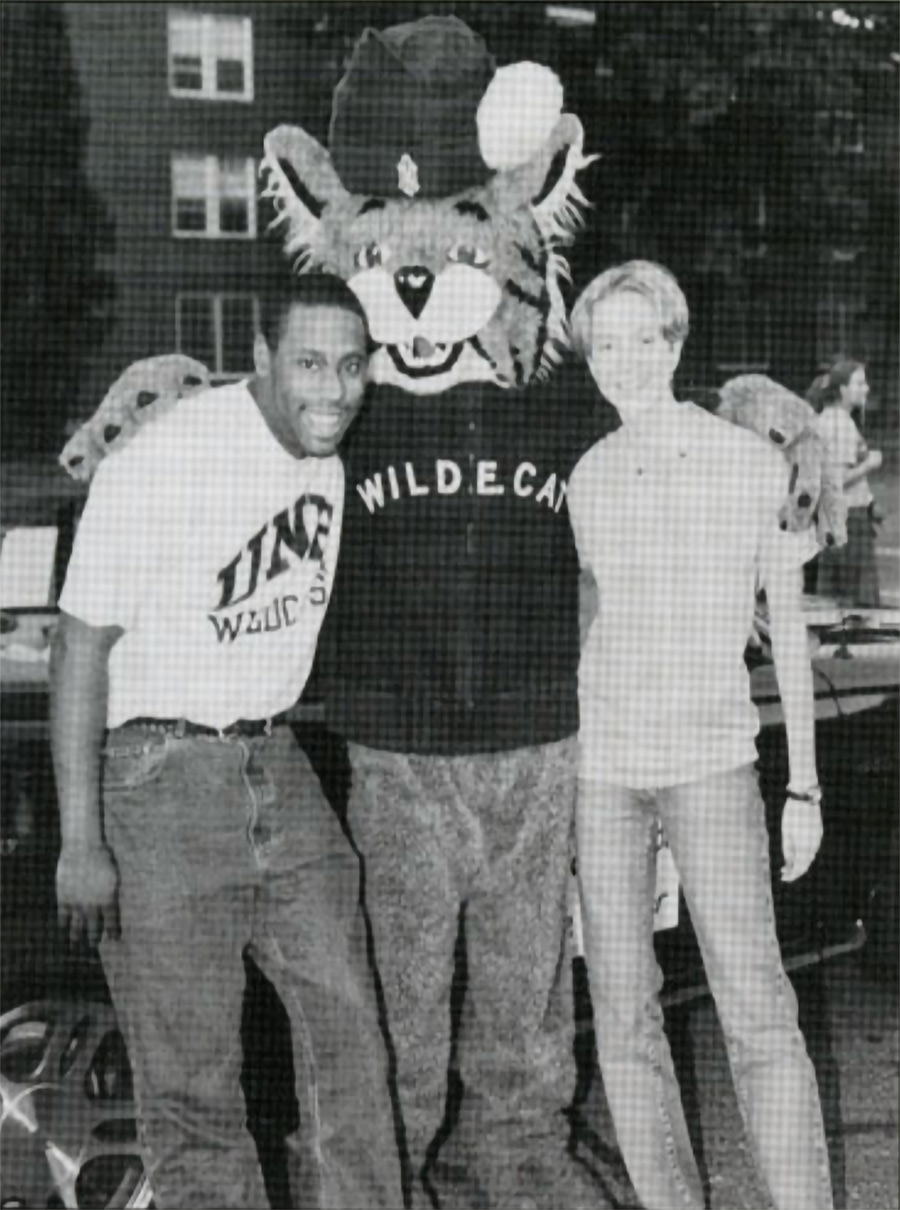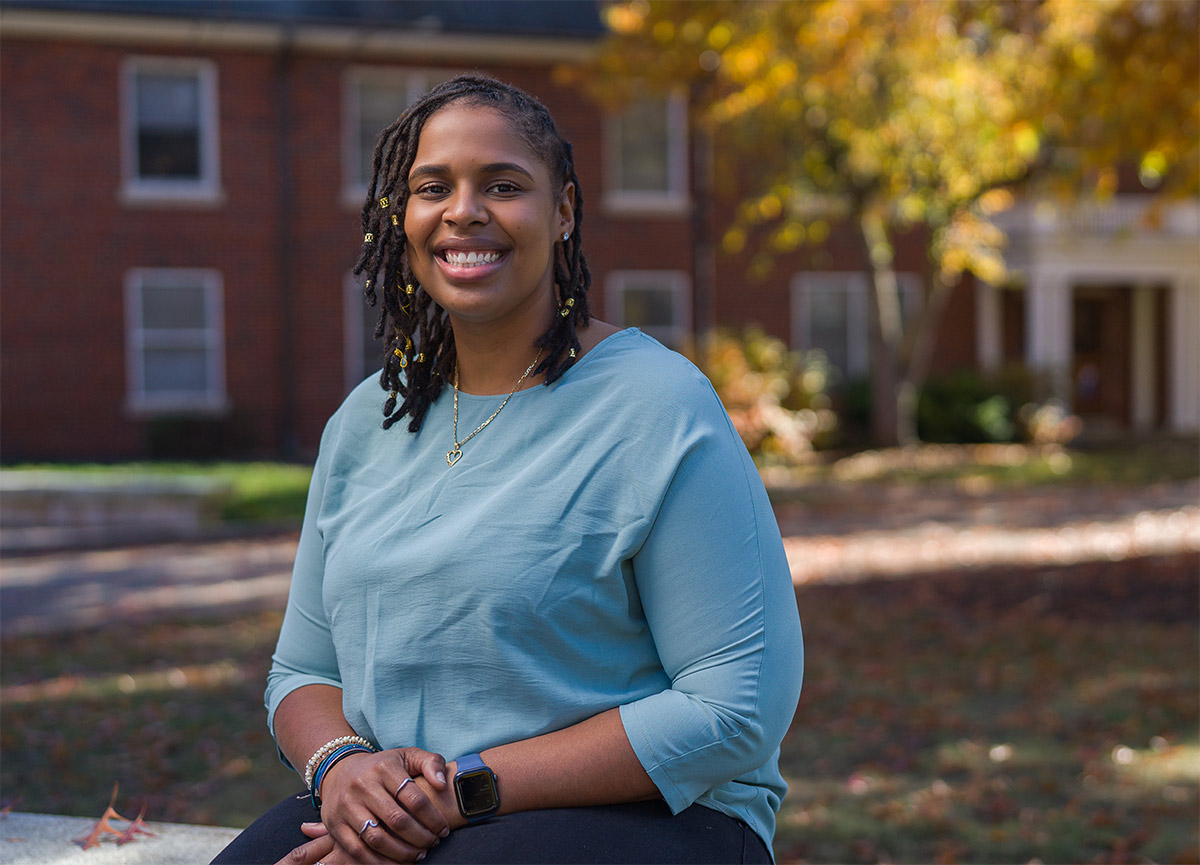
arnelle Bosquet-Fleurival’s Monday begins with the shrill sound of her alarm at 6 a.m., a painfully early start given that her first task is to sift through reports detailing the reality of supervising residence halls during a weekend on a college campus.
There are documents to file with administration and incidents to review, often beginning with minor infractions but commonly including violations centered on racial and cultural insensitivity. As an assistant director of residence life supervising four hall directors — a position she previously held on campus for several years — her experience encountering reports of racial or homophobic slurs scribbled on white boards or sexually offensive messages scattered throughout hallways is certainly not unique among fellow staffers.
Her experience differs greatly from the vast majority of her coworkers in one significant way, though.
Bosquet-Fleurival is in her second stint with residence life at UNH, having resigned just prior to discovering the slur outside her apartment door in 2017. The incident came on the heels of several other “racialized events” happening over several months throughout campus that she says created the tipping point for her to step away immediately to seek other opportunities.
As fate would have it, one such opportunity brought her back to campus just a few months later, when she was offered her current role as an assistant director with residence life. Despite some personal misgivings, she took the plunge, hoping to use the return as a way to play a role in driving change in the racial climate on campus.
So, a little more than three years later, is she happy she returned?

Bosquet-Fleurival is hardly alone wrestling with that conundrum. Racial diversity, in the student body and among faculty and staff, has been a significant struggle for UNH for decades. Creating an environment that feels welcoming and supportive for Black students and faculty — and is largely devoid of racism, overt or covert — has been particularly challenging, and the campus remains overwhelmingly white. According to data from UNH’s Office of Institutional Research and Assessment (IR&A), only 1.27 percent of more than 16,000 UNH students identified as Black or African American in 2019.
Many Black students and faculty members who choose to stay at UNH remain steadfast in their hope for positive change in the future. The murders of George Floyd and Breonna Taylor and the shooting of Jacob Blake by police officers have shined an incandescent spotlight on racial injustice throughout the country in recent months, and the critical conversations that have been sparked nationally by those incidents have taken root on campus, as well.
In late spring, on the heels of the George Floyd murder and growing national unrest, UNH President Jim Dean promised an action plan to address the issues on campus. In September, he announced several diversity, equity and inclusion initiatives, including creating a more diverse student body, faculty and staff and “an inclusive and welcoming environment for all, especially people of color.” The initiatives include a promise that “leadership teams will proactively address diversity and inclusion.”
In August, the university named Nadine Petty as chief diversity officer and associate vice president for community, equity and diversity, and welcomed Kenneth Holmes as the new senior vice president for student life. Both are Black.
assistant professor of education
And that requires a commitment from everyone.
“No matter where you are, if you think racism isn’t there, you’re not paying attention,” Julian Maduro ’21 says. “I’m tired of having people tell me we don’t have racism at UNH when the people of color here know intimately well that there is racism here. And it is not our burden alone to know all the racist things that are happening in the shadows and behind closed doors — it’s everybody’s duty to know, everybody’s duty to educate themselves and everybody’s duty to do better.”
Jade Lee, assistant professor of education in the College of Liberal Arts, believes part of that duty is understanding and embracing antiracism, a form of action against racism and the oppression of marginalized groups brought to the mainstream in Ibram X. Kendi’s book, “How to Be an Antiracist.”
“At UNH, people sometimes feel like if they are not participating in the hatred, they are doing the right thing. Being antiracist means more than not calling Black people slurs behind closed doors. It means if someone in your sphere calls a Black person a slur, what do you do?” Lee says. “I don’t think enough people at UNH subscribe to antiracism. I think they feel, ‘I don’t do racist things, so that’s the best I can do.’ That, to me, is not making progress. That, to me, is not the best UNH can do. And that means we have a lot of work to do.”
As a freshman at UNH in 1993, Jackson followed close to 3,000 fellow first-year students into the field house for an orientation session. But when he stopped and looked left, looked right and looked behind him, he noticed something that made his “stomach sink” — his was the only Black face in the crowd.
“Sometimes I joke that I thought maybe this was everybody else’s session, and there was a session for Black students somewhere else,” Jackson says. “When I actually came to terms with it, (I realized) I had signed up to attend a school that at the time had only 54 black students in the whole student body.”
The state is 93.1 percent white overall.
The data presents the struggle in terms of recruiting and retaining both students and faculty of color. Despite welcoming students from 48 states and nearly 70 countries, the percentage of Black students at UNH remains consistently below 2 percent.
Retention has been particularly challenging among faculty. While the total number of Black faculty members hired since 2004 has increased, the percentage of UNH faculty that is Black has remained flat, fluctuating from a low of 0.9 percent to a high of 1.3 percent and back again. The number in 2019 was 0.9 percent — identical to the percentage in 2004. Furthermore, there were 12 faculty members who identified as Black or African American according to 2019 IR&A data, which is the same number as in 2010.
Neither milestone has been achieved.
The campus demographic statistics create something of a double-edged sword for UNH in terms of student recruitment — there isn’t enough diversity to paint a picture that would inspire all Black students to believe they can find a community on campus, and those that do choose to attend often discover that reality and opt to leave — or struggle to balance academics and the desire to improve the situation for themselves and others.
Jackson’s experience bears that out. Once he realized how few Black students were at UNH, he set out to make sure the ones who were there — with him and after him — felt supported. He and a small group of fellow students formed the organization that would come to be the Black Student Union, making four demands of the administration: admit more non-athlete students of color; admit and hire more women of color; establish a pre-orientation for students of color; and create an office of multicultural student affairs (OMSA) — which to that point was “just a phone on someone’s desk,” Jackson says.
Those changes took root — the Black Student Union is still an active program, the CONNECT program was formed and still helps people from minority populations transition to college and OMSA — now the Beauregard Center — continues to be a critical resource for students of color on campus. But all the work required to implement that change took its toll on Jackson.
There was nobody else to do what John Laymon ’73 did when he was on campus, either. Laymon came to UNH from Pittsburgh, Pennsylvania, and was a member of the basketball team — but he was also the first Black student to graduate from UNH with an engineering degree.
Laymon was inducted into UNH’s Diversity Hall of Fame in 2008 and later helped resurrect it after several years of inactivity due to lack of funding. He partnered with then-OMSA director Sean McGhee to establish a UNH Pioneer Black Alumni, Family and Friends Reunion and Diversity Hall of Fame induction ceremony held in 2015 and 2017.
Laymon — who attended a high school that was essentially “50-50” in terms of Black and white students — estimates that there were about 30 Black students out of a population of roughly 10,000 when he attended UNH, and that “90%” of the Black students then were on academic scholarships (he estimated that the other 10% were on athletic scholarships).
He believes that the best way to recruit and retain a larger cohort of Black students is to follow a similar approach today.
Jackson, too, grew up in a racially diverse atmosphere in Boston and attended UNH in large part because of financial aid, having initially set his sights on historically Black Morehouse College before receiving a less appealing scholarship package there.
“I had to make a place for myself at UNH, and in making that place I purposely tried to do things that made a place for other people, too,” Jackson says. “I think about whose job and whose responsibility it is to be active in being a change agent around racial issues and closing these disparities, and it can’t only be people of color.”
As a member of the UNH men’s basketball team — and the team’s leading rebounder and second-leading scorer last season — he has grown accustomed to being in the limelight in front of hundreds of energized fans.
Having those eyes follow him when he walks into any of his classes at UNH — in large part because he’s a 6-foot-5-inch Black man — has been a bit more of an adjustment.
“You get a lot of people staring at you because you don’t look like everybody else,” Sutherlin, who grew up just outside of Minneapolis, Minnesota, and helped organize a group of more than 40 to help clean up the city after the protests in the wake of George Floyd’s murder, says. “It’s not necessarily a problem, but it can be kind of a distraction.”
“You never hear a room quiet as quickly as HoCo when a group of Black students walks through and every head turns and looks,” she says.
That sense of never being able to blend into the crowd is a constant for many Black students —and faculty members. Given the comparatively low number of people of color on campus and the fact that many students who attend UNH have grown up in overwhelmingly white spaces, it can be challenging for Black students and faculty members to find a sizeable community of people they feel can understand or relate to them.
“A lot of my students might have never had a Black woman as an instructor, or might have never had anyone that wasn’t white as an instructor,” Lee says. “If you have grown up only with people who believe the same things you believe and who only look like you, you are not even accustomed to interacting with people who are different than you.”
More overtly racist incidents occur, as well. Maduro recalls a discussion in the Beauregard Center where Black students shared stories of incidents they or their friends had encountered, from hearing racial slurs to being spit on to having rocks thrown at them.
Taryn Duncan ’21 grew up in a culturally diverse area near Hartford, Connecticut, and describes her UNH experience as a “bumpy ride.” She recalls an incident as a freshman in which a car suddenly accelerated toward her and a group of friends crossing the street, and as they leaped toward the sidewalk, the driver shouted the N-word at them.
“It’s been difficult at times. I’ve experienced a lot of stuff I wasn’t prepared to experience,” Duncan says. “I can go days without seeing anyone that looks like me.”
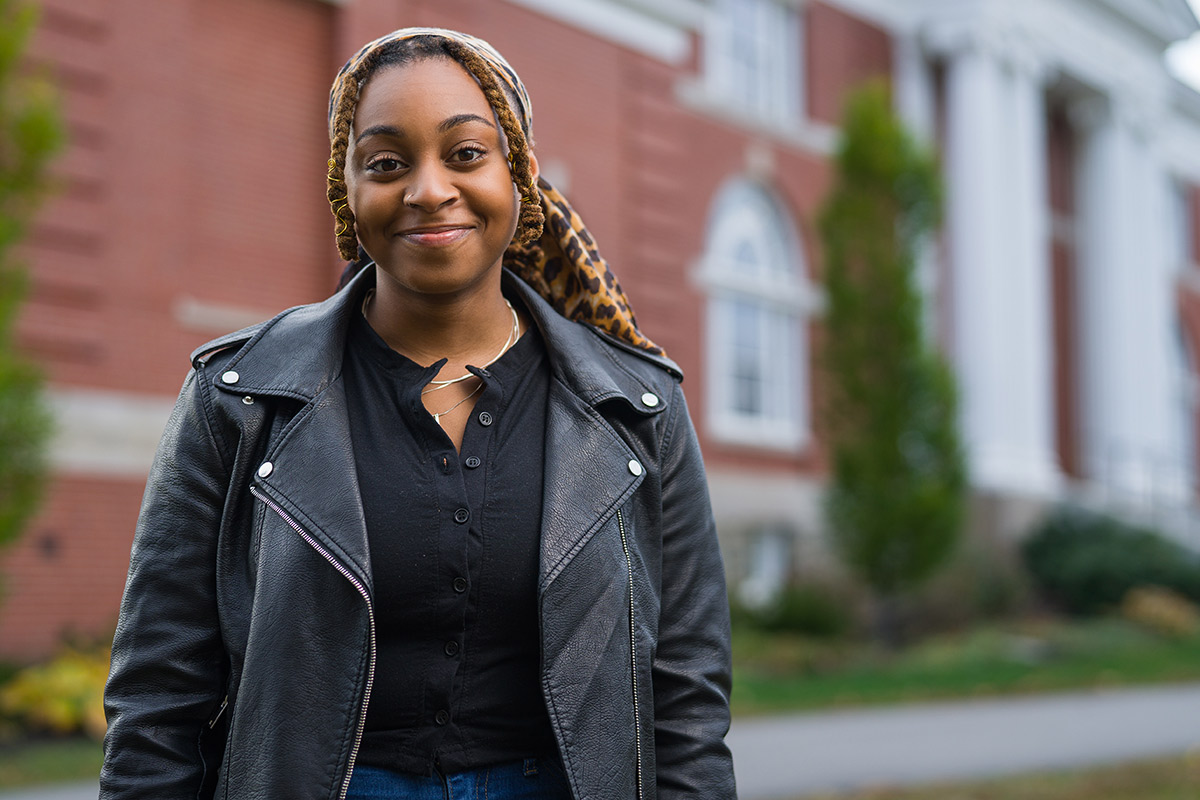
Incidents remain extremely common in residence halls, too. Bosquet-Fleurival noted that there were 19 reported bias incidents during September this year (compared to 13 last year), and that there have been years in the recent past in which more than 100 such incidents have been reported (bias incidents aren’t strictly racial — they are considered incidents motivated by any form of prejudice — but race was one of the identities listed as most “highly impacted” by the incidents this September).
“It’s pretty prevalent,” Bosquet-Fleurival says of racially insensitive activity in residence halls. “I encounter microaggressions on a daily basis.”
The frequency of all that activity — the more striking incidents coupled with the recognition that it’s almost impossible not to stand out — can take its toll. Both Duncan and Maduro confessed they are often fighting back against burnout.
“There’s usually a mid-semester fatigue for me where I just get exhausted from having to explain the experience of my existence. It’s kind of an energy zap,” Maduro says.
It’s not just students experiencing that strain. Baumgartner — who was recently named a Faculty Fellow for Equity and Inclusion — is on research leave this academic year, and one of the things she is exploring is data surrounding UNH’s struggle to retain professors of color once they are hired.
Baumgartner has had a very positive experience at UNH, one she credits to supportive colleagues in her department and college, as well as the “curious and smart students” she’s worked with.
“I don’t want my overwhelmingly positive experience to be used as an example for everyone,” Baumgartner says. “I know one of the faculty members who left was constantly mentoring students of color, and that mentoring is really essential and wonderful work, but for that faculty member it also took away from their time for research.”
Adds Lee: “I want to be a part of the change that I want to see, but I also know that folks need to be mindful of the burden for faculty of color and students of color, that when something happens — nationwide or on campus — that’s where you go to. That’s a lot for someone who is already burdened with the oppression they experience on a regular basis. That’s an extra layer of burden, especially when it comes to moving UNH forward, that shouldn’t be our work.”
The importance of support.
It’s what Jackson sought to put in place for others that came after him when he and his peers advocated for the creation of outlets like the Beauregard Center and unique orientation programming.
For Maduro, it’s a big part of what has kept her at the university.
“I can’t imagine being a UNH student without the Beauregard Center. To be honest, I think I would have transferred without it,” Maduro says. “It’s a place where we all have a healthy respect for each other, and you can hang out and not have to worry about anything.”
This summer the Beauregard Center offered a program to provide “processing spaces” for Black students following the high-profile incidents of violence against Black people — a program facilitated by two Black staff members “who share many of the same hurts and traumas as Black students on campus,” Caché Owens-Velásquez, director of the center, says.
assistant director of residence life
“I view the center as a place where students can show up as their whole selves and still feel welcome, safe, celebrated and supported,” Owens-Velásquez says. “There is a rich diversity within the Black community on campus, so the center serves as a place for students of all backgrounds to dialogue and learn from one another.”
Beyond the BSU, Maduro points to other student organizations like NALA, a support group for women of color, and MOS:DEF (Men of Strength: Diversity, Education and Family), a support group for men of color — as well as the Queer and Trans People of Color (QTPOC) group — as invaluable outlets for students of color to find peers with whom to connect and discuss their experiences.
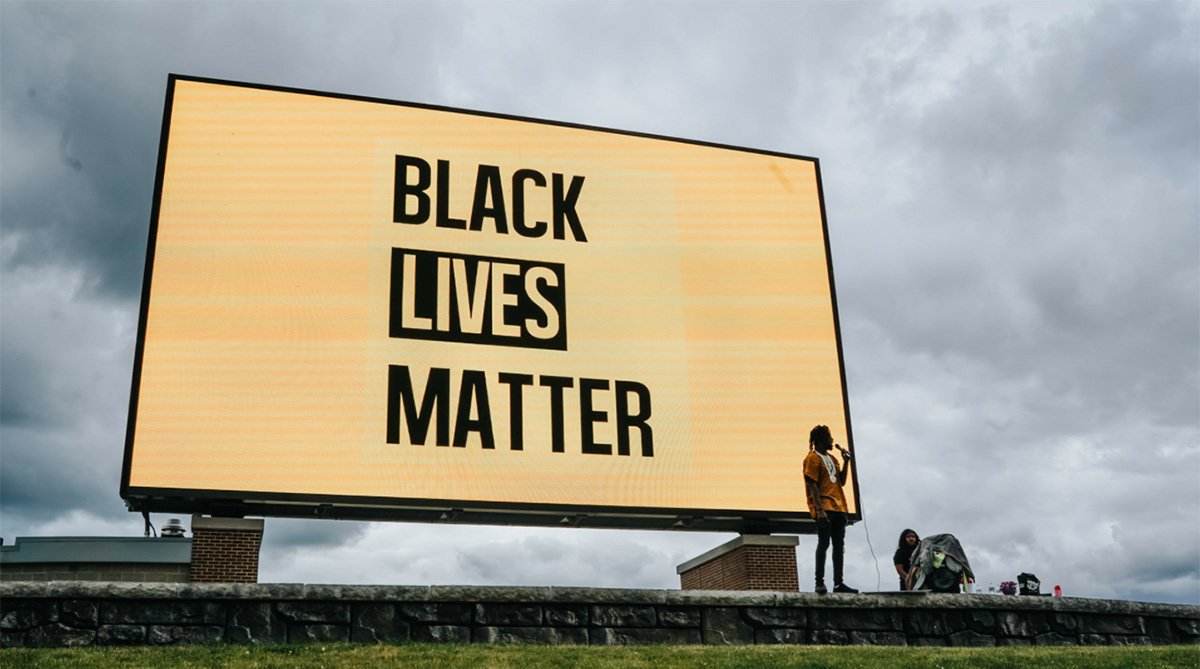
Duncan is hopeful that the work they do can take some of the pressure off the aforementioned organizations and help shift the burden of support more evenly throughout campus.
“We are really looking for the university to see us,” Duncan, who has been involved with the CONNECT Program as a mentor and team leader and currently works at the Beauregard Center, says. “It shouldn’t be on these programs and these groups alone to be the reason why students of color stay. The school itself should be inclusive, and it should hold students who aren’t inclusive accountable.”
A key to creating a sustainably supportive environment in the eyes of several current Black faculty and staff members is the continued need for more Black people in positions of support throughout campus. The Beauregard Center currently operates with a full-time staff of three people, which Bosquet-Fleurival believes is far too few.
“I think our students of color would say they don’t have enough support. To them, support means representation — seeing people that look like them in different positions across campus. And that’s not our truth right now,” Bosquet-Fleurival says.
One of Bosquet-Fleurival’s main goals in returning to residence life was to improve the support available for students victimized by bias incidents, and she has since established a better structure of reporting incidents to Affirmative Action and involving that outlet in sorting them out while also working to illustrate the support services available to each affected individual personally.
Students, too, would like to see the outlets for support better promoted — instead of the photos of themselves they see used on flag poles and brochures to create an illustration of diversity. Maduro, in particular, noted that given the overall lack of diversity on campus and the frequency with which the same Black students and other students of color often appear in marketing materials for recruitment and promotion, students begin to feel tokenized.
“The best thing UNH could do for recruitment of students of color is take care of the ones who are already here,” Maduro says. “Once students of color here are happy, safe and comfortable, more students of color are going to want to come.”
The same can be said on the faculty side. Baumgartner noted that other universities have set specific goals for hiring of Black faculty and staff over a certain period of time and aimed to achieve those goals through the use of resources like Mellon Grants or endowed professorships.
The state demographics present an additional challenge for the university, particularly when it comes to retaining faculty of color. Both Lee and Bosquet-Fleurival confessed they’ve struggled to feel settled in the communities they live in outside of campus, which are almost exclusively white and haven’t felt overly inclusive.
Baumgartner called on UNH donors as a key to creating change in the area of retention for faculty of color, by designating contributions to specific issues related to racial equality such as professorships, scholarships and lecture series. She said she’d like to see the university aim for 5% Black faculty representation.
“I want to see big numbers. We need something substantial,” Baumgartner says. “When prospective job candidates are applying, if they see a revolving door of faculty of color, they may say that’s not a place I want to be. By having a commitment to hiring faculty of color and creating a truly welcoming environment for them, then I think we can achieve that lasting change.”
That remains the single most elusive element, despite small steps forward at times, despite initiatives and pledges and promises from various people in positions of leadership over multiple decades and university administrations.
There is genuine optimism that President Dean and current university leadership are putting the pieces in place to begin that journey in earnest. Placing the right people in positions of influence and establishing measurable goals — as well as engaging the appropriate people on campus for influential conversations and holding university leadership accountable for creating the necessary change — have left an impression.
“There is a lot to be said for leadership, and I believe we are on a path with a generational leader in President Dean, who is poised to do the right thing,” Jackson says. “I can’t say that was always the case in my relationship with the university. But I definitely believe the current leadership is headed in the right direction.”
director of the Beauregard Center
Sutherlin notes that he was lucky to find a strong sense of community among his basketball teammates but encourages the university to more actively recruit non-athlete students of color.
Similarly, Bosquet-Fleurival suggests the university could more fully engage in recruitment of faculty and staff of color by tailoring its approach, offering information about inclusive and diverse options that exist in the area, including Black-owned restaurants and businesses.
Regardless of the specific steps, though, progress will be measured by some based on whether things move beyond well-crafted mission statements and newly established committees to fulfillable action items with legitimate financial backing and infrastructure to sustain over the long haul.
“If you are not putting money behind it, you can’t say you care about it,” Lee says.
Some of that activity is already underway. UNH recently unveiled the Postdoctoral Diversity and Innovation Scholars program, designed to open “a pathway to the professoriate for highly talented, underrepresented postdoctoral scholars.” The program is funded by the colleges and UNH administration.
For all the necessary changes that can be driven by leadership-fueled initiatives, though, it’s the culture in the classrooms and the residence halls and walkways throughout campus that needs to change in order for students and faculty members of color to fully embrace UNH as home.
associate professor of English and women’s and gender studies
It’s not about not seeing race. It’s about celebrating it.
“I don’t want people to see me and be colorblind. I want them to know I’m a Black woman, because there are so many amazing things that come along with being a Black woman,” Maduro says. “Take yourself out of that nameless crowd and make yourself actively anti-racist. That is the only way to be an ally, and the only way to make change for the future.”


